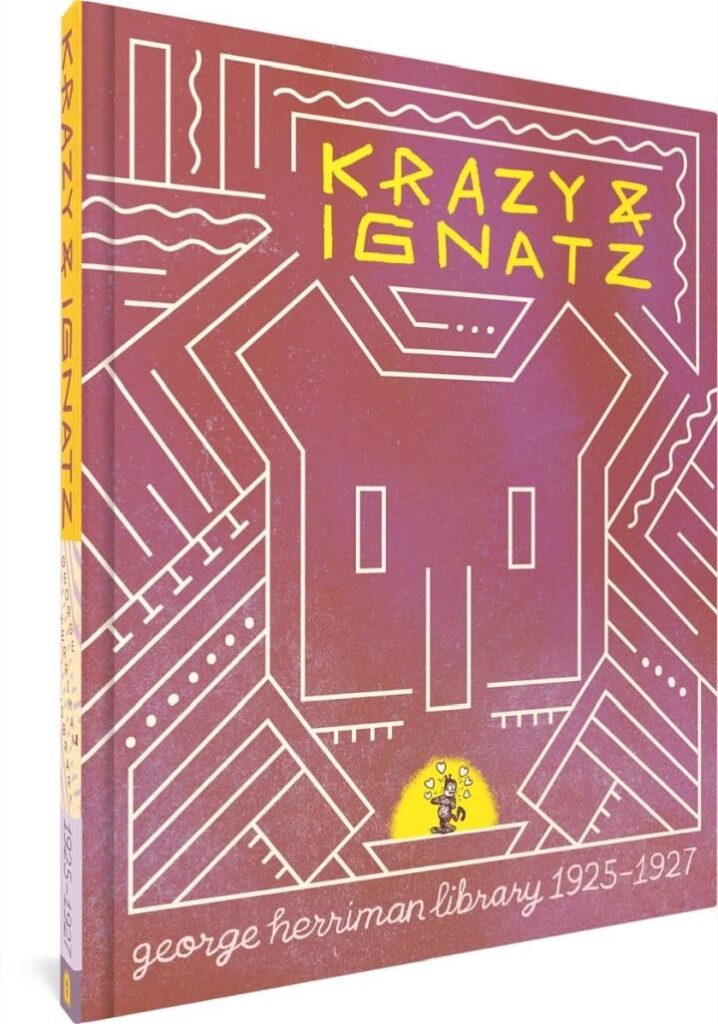
Krazy Kat is the kind of thing that doesn’t happen. The comic strip ran for almost 30 years despite irritation from editors and confusion from its audience. It was a rare modern example of patronage. William Randolph Hearst, a newspaper mogul (and famous inspiration for Citizen Kane), loved it. So, it kept running.
The basic premise of the strip was simple, if strange. Krazy Kat was a cat in love with a mouse, Ignatz. Ignatz, resenting Krazy’s affection, sought to throw a brick at the back of Krazy’s head daily. Krazy takes this as a sign of love, and looks forward to the brick. Officer Pup, the local constable who himself loves Krazy, is constantly monitoring and arresting Ignatz. Odd and repetitive as this contrivance of circumstances is, author George Herriman parlayed it into a beautifully varied series.
Set in a wildly stylized version of Coconino County, Arizona, the strip features a variety of secondary animal characters: Kolin Kelly, the dog brick maker; Mrs. Kwakk Kwakk, the local duck gossip; Joe Stork, the stork forever threatening the residents of Coconino with children.
The George Herriman Library: Krazy & Ignatz 1925-1927, published by Fantagraphics, contains all of the black and white Sunday strips for Krazy Kat in those years. It’s a hardcover book, about 11 by 14 inches. Fantagraphics had previously published several volumes of Sunday Krazy Kats in paperback in a 9×11 format. This larger format is clearer and brings out more details in the illustrations.
The appeal of Krazy Kat, besides the obvious humor, are how many vectors of strangeness George Herriman was able to introduce into his simple format of Kat vs. mouse vs. dog. First, there’s the illustrations. While the dialogue followed from panel to panel, the background illustrations never do. Every single panel of a Krazy Kat comic seems to take place in a wildly different place than the last. Formations (largely inspired by the Arizona desert) shift from panel to panel, enriching but never interrupting the story flow.
Second was Herriman’s use of language. Several of the characters, include Krazy himself, speak in a patois that resembles English, but isn’t strictly grammatical… or sensical. An example: Krazy, deciding what to do for the night, says: “If I had widda to go at, then would I go widda – but wedda I go widda or wedda I go not widda I still would not know if I went widda or not – so why go widda wen one can go wence.”
I haven’t figured this one out yet. And that’s part of Krazy Kat’s charm, and why he’s been a tough sell his whole existence. The language can be dense, and deciphering the patois and the visual games and the story takes an intellectual toll. These collections are more for dipping in than reading through, in my experience.
Still, there’s a reason Krazy Kat was Calvin & Hobbes creator Bill Watterson’s main inspiration. In these simple Sunday strips, there’s so much imagination. Wordplay, visual, and textual stimulation. It’s no wonder they were never particularly popular. This is work.
But it’s also beautiful, and the book Fantagraphics has put together is beautiful, too. The hardcover book is very large, with a nicely textured cover and a lot of bonus material. Besides some essays, there’s extra comic material from George Herriman’s other work, and even some sheet music from ragtime music inspired by the comic.
Krazy Kat may not be for everybody. It’s weird. It’s a bit of a challenge – not from the content, but just the form and the playful language which takes an engaged mind. But it’s also just a lovely comic strip and I might be taking it too seriously. It’s funny, and more than funny. I’m glad it’s being lovingly preserved in this volume.